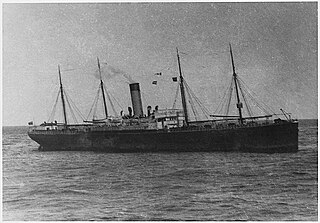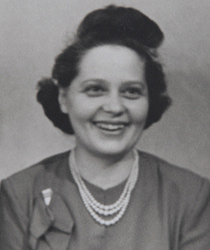
RMS Olympic was a British ocean liner and the lead ship of the White Star Line's trio of Olympic-class liners. Olympic had a career spanning 24 years from 1911 to 1935, in contrast to her short-lived sister ships, Titanic and Britannic. This included service as a troopship during the First World War, which gained her the nickname "Old Reliable", and during which she rammed and sank the U-boat U-103. She returned to civilian service after the war, and served successfully as an ocean liner throughout the 1920s and into the first half of the 1930s, although increased competition, and the slump in trade during the Great Depression after 1930, made her operation increasingly unprofitable. Olympic was withdrawn from service and sold for scrap on 12 April 1935, which was completed in 1937.

HMHSBritannic was the third and final vessel of the White Star Line's Olympic class of steamships and the second White Star ship to bear the name Britannic. She was the youngest sister of the RMS Olympic and the RMS Titanic and was intended to enter service as a transatlantic passenger liner. She was operated as a hospital ship from 1915 until her sinking near the Greek island of Kea, in the Aegean Sea, in November 1916. At the time she was the largest hospital ship in the world.

John Jacob Astor IV was an American business magnate, real estate developer, investor, writer, lieutenant colonel in the Spanish–American War, and a prominent member of the Astor family. He was among the most prominent American passengers aboard RMS Titanic and perished along with 1,495 others when the ship sank on her maiden voyage. Astor was the richest passenger aboard the RMS Titanic and was thought to be among the richest people in the world at that time, with a net worth of roughly $87 million when he died.

An ocean liner is a type of passenger ship primarily used for transportation across seas or oceans. Ocean liners may also carry cargo or mail, and may sometimes be used for other purposes. The Queen Mary 2 is the only ocean liner still in service to this day, serving with Cunard Line.

SS Californian was a British Leyland Line steamship. She is thought to have been the only ship in sight of the Titanic, or at least her rockets, during that ship's sinking. The crew took no action to assist.

Thomas Andrews Jr. was a British businessman and shipbuilder, who was managing director and head of the drafting department of the shipbuilding company Harland and Wolff in Belfast, Ireland. He was the naval architect in charge of the plans for the ocean liner Titanic and perished along with more than 1,500 people when the ship sank on her maiden voyage.

Lillian Gertrud Asplund was an American secretarial worker who was one of the last three living survivors of the sinking of RMS Titanic on April 15, 1912, and the last living survivor with memories of the disaster.

Violet Constance Jessop was an Irish-Argentine ocean liner stewardess and Voluntary Aid Detachment nurse in the early 20th century. Jessop is best known for having survived the sinking of both RMS Titanic in 1912 and her sister ship HMHS Britannic in 1916, as well as having been aboard the eldest of the three sister ships, RMS Olympic, when it collided with the British warship HMS Hawke in 1911.

On April 14, 1912, the Titanic collided with an iceberg, damaging the hull's plates below the waterline on the starboard side, causing the front compartments to flood. The ship then sank two hours and forty minutes later, with approximately 1,496 fatalities as a result of drowning or hypothermia. Since then, many conspiracy theories have been suggested regarding the disaster. These theories have been refuted by subject-matter experts.

Candyman: Farewell to the Flesh is a 1995 American supernatural horror film directed by Bill Condon and starring Tony Todd, Kelly Rowan, William O'Leary, Bill Nunn, Matt Clark, and Veronica Cartwright. Written by Rand Ravich and Mark Kruger, it is a sequel to the 1992 film Candyman, which was an adaptation of Clive Barker's short story, "The Forbidden". Its plot follows a New Orleans schoolteacher who finds herself targeted by the Candyman, the powerful spirit of the murdered son of a slave who kills those who invoke him.

The Titanic has played a prominent role in popular culture since her sinking in 1912, with the loss of almost 1,500 of the 2,224 lives on board. The disaster and the Titanic herself have been objects of public fascination for many years. They have inspired numerous books, plays, films, songs, poems, and works of art. The story has been interpreted in many overlapping ways, including as a symbol of technological hubris, as basis for fail-safe improvements, as a classic disaster tale, as an indictment of the class divisions of the time, and as romantic tragedies with personal heroism. It has inspired many moral, social and political metaphors and is regularly invoked as a cautionary tale of the limitations of modernity and ambition.

Britannic is a 2000 spy television film directed by Brian Trenchard-Smith. The film depicts a heavily fictionalized version of the sinking of HMHS Britannic in 1916. The film portrays a German agent sabotaging her while she is serving as a hospital ship for the British Army during World War I. It stars Edward Atterton and Amanda Ryan, with Jacqueline Bisset, Ben Daniels, John Rhys-Davies, and Bruce Payne as co-stars. It first premiered on cable network Fox Family and was then broadcast in the United Kingdom on Channel 4.

RMS Titanic sank on 15 April 1912 in the North Atlantic Ocean. The largest ocean liner in service at the time, Titanic was four days into her maiden voyage from Southampton, England, to New York City, with an estimated 2,224 people on board when she struck an iceberg at 23:40 on 14 April. She sank two hours and forty minutes later at 02:20 ship's time on 15 April resulted in the deaths of more than 1,500 people, making it one of the deadliest peacetime maritime disasters in history.

The Olympic-class ocean liners were a trio of British ocean liners built by the Harland & Wolff shipyard for the White Star Line during the early 20th century, named Olympic (1911), Titanic (1912) and Britannic (1915). All three were designated to be the largest as well as most luxurious liners of the era, devised to provide White Star an advantage as regards to size and luxury in the transatlantic passenger trade.

Olivia Richards is a fictional character from the US NBC soap opera Sunset Beach, played by Lesley-Anne Down.

Raise the Titanic is a 1980 adventure film produced by Lew Grade's ITC Entertainment and directed by Jerry Jameson. The film, written by Eric Hughes (adaptation) and Adam Kennedy (screenplay), is based on the 1976 book of the same name by Clive Cussler. The storyline concerns a plan to recover RMS Titanic to obtain cargo valuable to Cold War hegemony.

TitanicBelfast is a visitor attraction in Northern Ireland, which opened in 2012. A monument to Belfast's maritime heritage on the site of the former Harland & Wolff shipyard in the city's Titanic Quarter where the RMS Titanic was built. It tells the stories of the Titanic, which hit an iceberg and sank during her maiden voyage in 1912, and her sister ships RMS Olympic and HMHS Britannic. The building contains more than 12,000 square metres (130,000 sq ft) of floor space, most of which is occupied by a series of galleries, private function rooms and community facilities.

Titanic is a four-part television serial and period drama written by Julian Fellowes. It is based on the passenger liner RMS Titanic, which sank in the North Atlantic Ocean in April 1912 following a collision with an iceberg on her maiden voyage from Southampton to New York City.

Alma Katsu is an American writer of adult fiction. Her books have been translated into over a dozen languages, and have been published in the United Kingdom, Brazil, Spain, and Italy.

The Hunger is a 2018 historical horror novel by Alma Katsu. It is a reimagining of the events of the Donner Party which includes supernatural elements. It received critical praise and was nominated for the 2018 Bram Stoker Award for Best Novel as well as the 2019 Locus Award for Best Horror Novel.




















